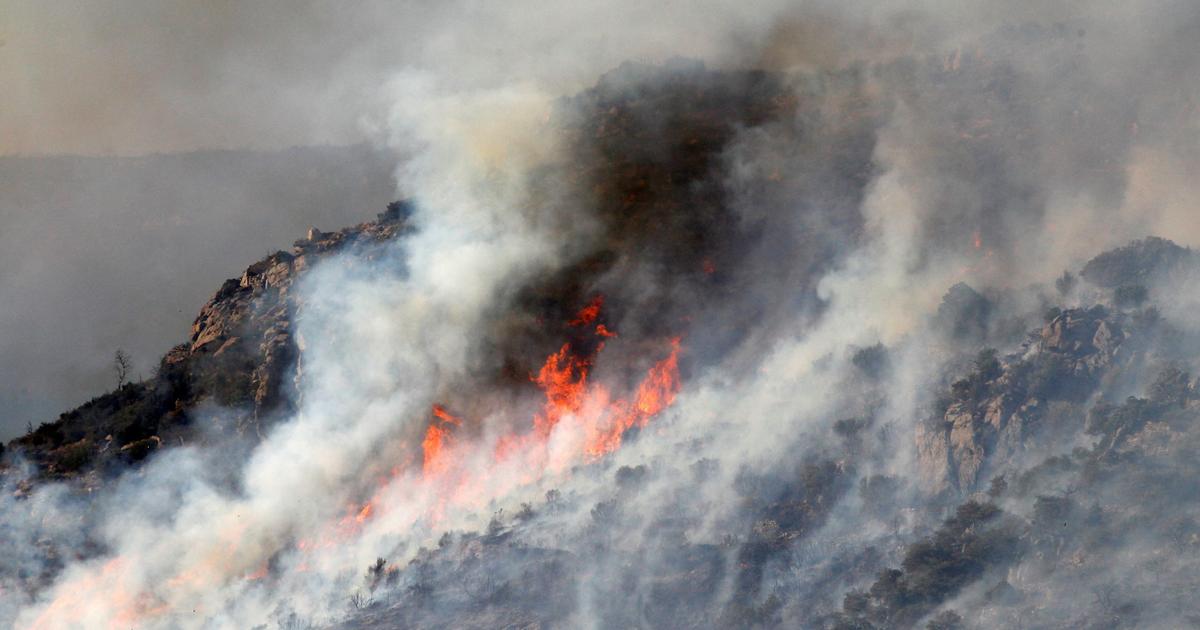In the heart of winter, the south of France is burning.
This Sunday, February 5, a fire again ravaged 60 hectares near the town of Torreilles, not far from Perpignan in the Southwest.
The fire, fanned by strong winds, mobilized 70 firefighters for several hours before being brought under control on Sunday.
Also in the Pyrénées-Orientales, firefighters had already intervened on Friday in the town of Corneilla-la-Rivière where eight hectares burned in less than half an hour.
Another fire broke out on Saturday afternoon, 30 kilometers away.
An unprecedented succession of fires for the month of February.
Same thing in the Hérault.
In this department, firefighters intervened 23 times on Saturday alone.
In the Bouches-du-Rhône, the Alpilles massif also caught fire on Saturday, losing some 130 hectares, engulfed by the first major fire of the year.
Of course, the battle waged by the firefighters echoes that waged last summer.
France had then experienced an epidemic of forest fires of unprecedented force, particularly in New Aquitaine and Brittany.
But this time, the 5 to 10°C recorded in the south did not prevent the vegetation from catching fire with such unprecedented and worrying force.
In the Perpignan region, the burned areas increased by 40% compared to last year at the same period, according to the Departmental Fire and Rescue Service (SDIS).
How can France ignite in this way, with temperatures so unfavorable to the start of fires?
Read alsoForest fires: the deadly summer
Origins still unknown
To determine the origin of the fires, the Pyrénées-Orientales gendarmerie has opened several investigations.
That of Sunday started very close to the D81, at 3 p.m. in the afternoon, “
an hour of great passage and in a very busy area
”, specifies the group of the departmental gendarmerie in
Figaro
.
“
There will be hearings of witnesses, but without excluding any hypothesis, it looks more like a cigarette butt than a criminal act as we saw last summer
”, explains a source close to the investigation.
“
The problem is that with such a wind, it takes everywhere.
Like last August
.
Asked about this last point,
La Chaîne Météo
* explains that an exceptional drought added to particularly strong winds favored, in the south-west, ideal conditions for the spread of fires.
“
The entire Montpellier region has been subject to a meteorological anomaly since the beginning of January, with major gusts of Mistral and Tramontana
,” explains Pascal Scaviner, head of the forecast service.
"
Since January 15, the department has experienced 14 days of winds up to 85km / h
".
Read alsoIs the number of forest fires really increasing in France?
Added to this phenomenon is a particularly intense drought.
“
In Perpignan, an average of 50 millimeters of precipitation falls per month in winter, as much as in Paris.
This last month, there have only been 19 millimeters!
“, continues the meteorologist.
Since June 2022, the prefecture has never lifted the water restrictions, recalling again in January "
the extremely worrying situation of the state of resources
".
In the Perpignan area, the administrative court of Montpellier imposed in a decision taken in the fall to drastically reduce the levies in the Têt, the coastal river of the region.
“
In recent years, we may have had other rainfall deficits, especially in winter 2020-2021.
But never accompanied by such strong winds”
, continues Pascal Scaviner.
"
Thus, the combination of very low soil humidity, dry air and fast wind favors the appearance and development of fires
", concludes the meteorological expert.
As dry as August
For his part, the vice-president of the National Federation of Firefighters of France (FNSPF), the Comptroller General Éric Florès, nuance.
“
There have always been winter fires
”, he says before explaining: “
At the end of winter, the sap of the plants falls.
As soon as we see the beginnings of sunny days and the wind blows, the plants are just as dry as in the middle of August, when they are full of sap.
No need to go looking for climate change
, ”says the firefighter.
For Éric Florès, the 35 fire starts managed by his teams and himself during this weekend alone in the Hérault are “
normal activities
”.
“
It almost always comes from human activities.
In winter, people clean their fields, their forests, their ditches, they burn the branches but do not stay until the fire goes out,”
he explains.
The firefighters thus call for caution, and recall that it is forbidden to burn plants as soon as the wind exceeds 40 km/h.
For its part,
La Chaîne Météo
ensures that the winds should calm down during February, thus reducing the risks.
“
Until February 20, the medium-term trend is fortunately not favorable to the winds
,” says Pascal Scaviner.
While insisting on the exceptional nature of the current wind and drought conditions, which are particularly favorable to fires, the meteorologist warns: a tendency to winter fires could take root in the long term.
“
What is true with climate change is that there is a high probability of seeing periods of extreme drought occur more frequently and more sustainably
,” warns the weather specialist.
*The Weather Channel belongs to the Figaro group.

